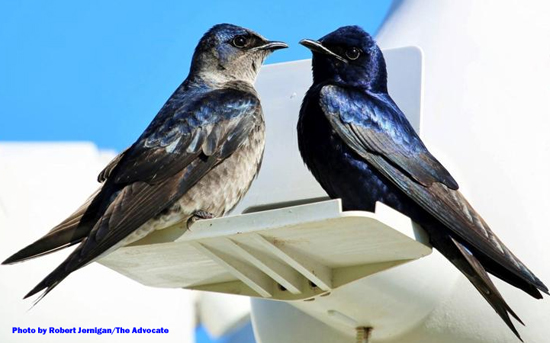In a sure sign that spring is not far behind, the first Purple Martins of the year have been spotted in Purcell, Oklahoma. The arrival, cheered by the Purple Martin Conservation Association in a national release today, reminds that Purple martins, the largest swallows in North America, became acclimated to the dried gourds hung by Native Americans and handcrafted birdhouses designed by European colonists. The prevalence of these ready-made houses, coupled with the decline of natural cavities, has changed the behavior of the species. Now, only man-made nests will do and it’s time for landlords to hoist the homes.
The birds were seen on February 8 in Purcell by a Purple Martin enthusiast – one of many throughout the eastern and central United States who track and report on the birds’ annual migration on behalf of the Association. The migration of these unique birds can be reported and tracked through a community science project called the Scout-Arrival Study.
“The first Purple Martin arrivals of the season are always an exciting event,” said Joe Siegrist, President of the Purple Martin Conservation Association. “Tracking the migration is not only fun, it also provides us with valuable information that helps inform our research and strengthen our efforts to make sure we’re doing everything possible to sustain the population of these amazing birds.”
North America’s largest species of swallow, Purple Martins winter in the rainforests of Brazil before making up to a 7000-mile migration north into the eastern United States and Canada.
The annual migration is a testament to the martins’ resilience as well as the unwavering dedication of thousands of ‘martin landlords’ who maintain multi-compartment nest ‘condos’ that are essential for the birds’ survival. Once widespread in rural America, this species, that eats billions of flying insects annually, has been disappearing at an alarming rate, experiencing a loss of one-third of its population over the last 50 years.
“The decline seems to be the combination of a few factors: nesting habitat loss, competing invasive species, decreasing prey availability, and climate change,” said Siegrist. “Over the majority of the Purple Martins’ range, they are unable to nest naturally any longer. Human-provided nest boxes are the only thing keeping the species alive east of the Rocky Mountains.”
Siegrist says the very survival of the species is due in large part to scores of dedicated conservationists who invest their time, money and hearts into maintaining housing for the martins.
Krista Adams, a Louisiana Master Naturalist and purple martin ambassador, and her family have been providing homes for purple martins for almost 20 years.
Four years ago, her family set up a purple martin colony at North Park, at the corner of Eden Church and Lockhart roads in Denham Springs, where anyone can stroll on paths and watch the birds dart in and out of their nesting gourds and houses to the ponds diving for insects. Last year, the Adams family set out 50 gourds in the park, which attracted 48 nesting couples.
“The growth has been phenomenal,” Adams said in an interview with The Advocate.
Like many people, Adams became enthralled with purple martins as a child when she would watch them with her grandfather at his camp in Grand Isle. The birds are fun to watch as they are “aerial insectivores,” feeding and drinking in the air. Purple martins do well in urban environments and aren’t skittish around humans.
“The landlords provide critical shelter for the martins,” Siegrist said. “In return, they are rewarded with a family-like bond with the birds who return to the same colony year after year like clockwork.”
To follow along with the Purple Martins’ migration and learn more about how you can help ensure the future of Purple Martins, visit www.purplemartin.org. In addition, people interested in learning more about how to attract and care for Purple Martins can receive a free booklet by contacting the Purple Martin Conservation Association by emailing info@purplemartin.org or calling 814-833-7656.
Based in Erie, Pa. the Purple Martin Conservation Association is an international tax exempt, nonprofit organization dedicated to the conservation of the Purple Martin through scientific research, state of the art wildlife management techniques and public education.The PMCA serves as a centralized data-gathering and information source on the species, serving both the scientist and Purple Martin enthusiast. The PMCA’s mission is educating martin enthusiasts in the proper techniques for managing this human-dependent species.

